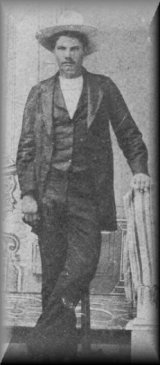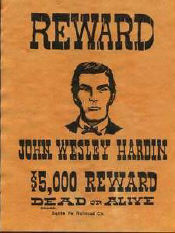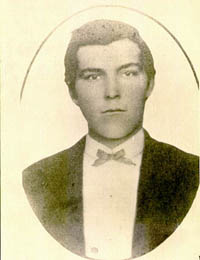"I never killed anyone who didn't need killing."
HARDIN, JOHN WESLEY (1853-1895). John Wesley (Wes)
Hardin, outlaw, son of James G.
 and
Elizabeth Hardin, was born in Bonham, Texas, on May 26, 1853. His father
was a Methodist preacher, circuit rider, schoolteacher, and lawyer.
Hardin's violent career started in 1867 with a schoolyard squabble in
which he stabbed another youth. At fifteen, in Polk County, he shot and
killed a black man as a result of a chance meeting and an argument. With
the Reconstructionqv government
looking for him, he fled to his brother's house, twenty-five miles north
of Sumpter, Texas, where in the fall of 1868 he claimed to have killed
three Union soldiers who sought to arrest him. Within a year, he killed
another soldier at Richard Bottom.
and
Elizabeth Hardin, was born in Bonham, Texas, on May 26, 1853. His father
was a Methodist preacher, circuit rider, schoolteacher, and lawyer.
Hardin's violent career started in 1867 with a schoolyard squabble in
which he stabbed another youth. At fifteen, in Polk County, he shot and
killed a black man as a result of a chance meeting and an argument. With
the Reconstructionqv government
looking for him, he fled to his brother's house, twenty-five miles north
of Sumpter, Texas, where in the fall of 1868 he claimed to have killed
three Union soldiers who sought to arrest him. Within a year, he killed
another soldier at Richard Bottom.
In 1871 Hardin went as a cowboy up the Chisholm Trail.qv He killed seven people en route and three in Abilene, Kansas. After allegedly backing down city marshall Wild Bill Hickok, who may have dubbed him "Little Arkansas," Hardin returned to Gonzales County, Texas, where he got into difficulty with Governor Edmund J. Davis'sqv State Police.qv Hardin then settled down long enough to marry Jane Bowen. Out of that marriage came a son and two daughters.
Hardin added at least four names to his death list before surrendering to the sheriff of Cherokee County in September 1872. He broke jail in October and began stock raising but was drawn into the Sutton-Taylor Feudqv in 1873-74. He aligned himself with Jim Taylor of the anti-Reconstruction forces and killed the opposition leader, Jack Helm,qv a former State Police captain. In May 1874 he started two herds of cattle up the trail; while visiting in Comanche he killed Charles Webb, deputy sheriff of Brown County.
From that time, Hardin was constantly pursued in
Texas. He went with his wife and children to Florida and Alabama, adding
one certain and five possible names to his death list before the Texas
Rangersqv captured him in Pensacola,
Florida, on July 23, 1877. He was tried at Comanche for the murder of
Charles Webb and sentenced, on September 28, 1878, to twenty-five years
in prison. During his prison term he made repeated efforts to escape,
read theological books, was superintendent of the prison Sunday school,
and studied law. He was pardoned on March 16, 1894, and admitted to the
bar.
In 1895 he went to El Paso to appear for the defense in a murder trial and to establish a law practice. Despite efforts to lead a decent life, he was soon in trouble. He took as his lover the wife of one of his clients, Martin Morose, and when Morose found out about the affair, Hardin hired a number of law officials to assassinate him. On August 19, 1895, Constable John Selman,qv one of the hired killers, shot Hardin in the Acme Saloon, possibly because he was not paid for the murder of Morose. Hardin died instantly and was buried in Concordia Cemetery, El Paso.
His autobiography, completed to the beginning of his law studies in prison, was the subject of some litigation and was published in 1896. Hardin was an unusual type of killer, a handsome, gentlemanly man who considered himself a pillar of society, always maintaining that he never killed anyone who did not need killing and that he always shot to save his own life. Many people who knew him or his family regarded him as a man more sinned against than sinning. The fact that he had more than thirty notches on his gun, however, is evidence that no more dangerous gunman ever operated in Texas.
BIBLIOGRAPHY: Mollie Moore Godbold, "Comanche and the Hardin Gang," Southwestern Historical Quarterly 67 (July, October 1963). John Wesley Hardin, The Life of John Wesley Hardin As Written by Himself (Seguin, Texas: Smith and Moore, 1896; new ed., Norman: University of Oklahoma Press, 1961). Leon C. Metz, John Selman (New York: Hastings House, 1966; 2d ed., Norman: University of Oklahoma Press, 1980). Chuck Parsons, The Capture of John Wesley Hardin (College Station, Texas: Creative Publishing, 1978). C. L. Sonnichsen, The Grave of John Wesley Hardin: Three Essays on Grassroots History (College Station: Texas A&M University Press, 1979).
Leon C. Metz
HARDIN, JOHN WESLEY. The Handbook of Texas Online

John Wesley Hardin
See Also:
-
Link to: Famous Texans Biograhphies
-
Link to: SWTSU Special Collections
-
Link to: John Wesley Hardin's Grave
 |
John Wesley Hardin, Dark Angel of Texas by
Leon Metz A fine book which reflects years of research and hard work. This brushes away the veil to reveal a dark and ruthless character. |
 |
Gunfighter:
An Autobiography by John Wesley Hardin, Mark Manning (Introduction)
|
| The Last Gunfighter : John
Wesley Hardin (The Early West) by Richard C. Marohn |
|
 |
The Letters of John Wesley Hardin by Roy & Jo Ann Stamps c.2001, pps. 342 This is a compilation of the many letters of John Wesley Hardin, (nearly 300) that provide a detailed account of his capture and imprisonment, his family relationships, his religious beliefs, his transformation into a lawyer, and his pardon by Gov. James Hogg. Has many reproduced photos of the family and also of original documents. |
 |
John Wesley Hardin : Texas Gunman by Lewis Nordyke |
 |
Life of John Wesley Hardin As written by
Himself by John Wesley Hardin Typically autobiographies by famous westerners are filled with more fiction than fact. This book, however, is accurate. There are some claims by Wes that can not be verified, but this book is worth a read. Issued with several different covers. |
 |
Pistoleer: A Novel of John Wesley Hardin by James Carlos Blake & William Windom |
 |
Richland Crossing, A Portrait of Texas Pioneers
by Walter Clay Dixson True stories of pioneer migration and Texas adventures of several families, including the John Wesley Hardin biography, with many old letters and photos, authored by Hardin's cousin. |
 |
John Wesley Hardin : Suppressed
Memories by Steppen Wirth |
 |
Lost Cause : John Wesley Hardin,
the Taylor-Sutton Feud, and Reconstruction Texas by Jack Jackson (Preface) |
|
|
Reflections in Dark Glass : The
Life and Times of John Wesley Hardin by Bruce McGinnis |
 |
The Capture of
John Wesley Hardin:
The Young West Series, Creative Publishing Company, 1978; 121 pages-
hardback. by Chuck Parsons |
 |
The Last Gunfighter John Wesley Hardin: Richard Marohn. Oversize book 7 1/2 by 10 1/4. Bound in brown cloth. 320 pages of double-column text |
 |
The Fued That Wasn't: The Taylor Ring, Bill Sutton, John Wesley Hardin, and Violence in Texas; by James M. Smallwood; Texas A&M Press, 2008 |
![]() This
Page Last Updated on
09/28/14
This
Page Last Updated on
09/28/14
Navarro County TXGenWeb
© Copyright 2001 Edward L. Williams & Barbara
Knox